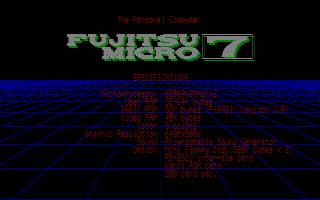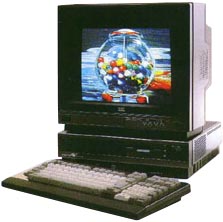Overview
 The demo screen for the FM-7
The demo screen for the FM-7The FM-7, an acronym for "Fujitsu Micro 7," was the second home computer released by the Japanese computing company Fujitsu. It was released in Japan in November 1982, for ¥126,000 ($500 in 1982 dollars, or $1200 in 2013 dollars). Alongside the Sharp X1 and NEC PC-8801, it was considered to be one of the big three Japanese personal computers of the early 1980s.
The most notable model for computer gaming was the FM-77 AV, which in 1985 introduced a simultaneous display of 4096 colors, surpassing the 8 color display of other 8-bit home computers at the time.
The FM-7 was released almost simultanously with the FM-11 EX (intended for businesses), and was preceded by the FM-8 (Fujitsu's first home computer release). Fujitsu were also later responsible for the FM Towns, the powerful 32-bit successor to the FM-7.
The FM-7 was similar to Radio Shack's TRS-80 Color Computer (colloquially referred to as the "CoCo") in some ways, especially CPU processor (both used the 8-bit Motorola 6809) and included features. One such feature is F-BASIC, very similar to the CoCo's "Microsoft CoCo BASIC." F-BASIC is essentially a simplistic programming language, including a katakana and kanji character set, graphics manipulation, and music.
Model Variants
There were several different versions of the FM-7 released following the initial release in 1982, including the FM-New 7 and FM-77.
A major breakthrough for computer gaming came in 1985, with the release of the FM-77 AV, the first computer model to break the 8-color barrier of 8-bit computers and achieve a simultaneous display of 4096 colors. In addition, the FM-77 AV also came with a built-in Yamaha FM synthesis sound board, providing higher-quality audio.
FM-7 models included:
 FM-77 AV FM-New 7 (1984)
FM-77 AV FM-New 7 (1984)- FM-77 (1984)
- FM-77 L2 (1985)
- FM-77 L4 (1985)
- FM-77 AV (1985)
- FM-77 AV20 (1986)
- FM-77 AV40 (1986)
- FM-77 AV20 EX (1987)
- FM-77 AV40 EX (1987)
- FM-77 AV40 SX (1988)
Technical Specifications
Processors
- Main CPU (Central Processing Unit) processor:
- 1982: Fujitsu MBL 68B09 (based on 8-bit Motorola 68B09) @ 4.9 - 8 MHz
- 1984: Fujitsu MBL 68B09 (based on 8-bit Motorola 68B09) @ 8 MHz
- 1985: Fujitsu MBL 68B09E (8-bit) @ 2 MHz (equivalent to MBL 68B09 @ 8 MHz)
- GPU (Graphics Processing Unit) processor:
- 1982: Fujitsu MBL 68B09 (based on 8-bit Motorola 68B09) @ 2 MHz
- 1984: Fujitsu MBL 68B09E (8-bit) @ 2 MHz
- 1985: Fujitsu MMR (Memory Mapping Register), Fujitsu MBL 68B09E (8-bit) @ 2 MHz
- Optional CPU processor: Zilog Z80 (8-bit)
Memory
- Main RAM (Random Access Memory)
- 1982: 64 KB
- 1984: 64-256 KB
- 1985: 128-256 KB
- 1986: 128 KB / 192 KB / 448 KB
- Video RAM (VRAM) memory:
- 1982: 48 KB
- 1985: 96 KB
- 1986: 96-144 KB
- 1987: 96-192 KB
- 1988: 192 KB
- ROM (Read-Only Memory) memory: 48 KB (1982), 72 KB (1985)
- Storage:
- Default: 10-20 MB hard disk drive (1982), 1x-2x 3.5" DD floppy disk drives (1984)
- Optional: Cassette tape, 5.25" floppy disk
- 3.5" DD (double-density) floppy disks: 320 KB each (1984), 640 KB each (1986)
Display
- Maximum display resolution: 640x200 pixels (1982), 640x400 pixels (1984)
- Maximum color palette: 8 (1982), 16 (1984), 4096 (1985), 262,144 (1986)
- Simultaneous display colors:
- 1982: 3 colors (monochrome), 8 colors (4-bit color)
- 1984: 8 colors at 640x200, 2 colors at 640x400
- 1985: 4096 colors at 320x200, 16 colors at 640x200, 2 colors at 640x400
- 1986: 4096 colors at 320x200, 16 colors at 640x200, 8 colors at 640x400
- 1987: 4096 colors at 320x200, 32 colors at 640x200, 16 colors at 640x400
- Monitors: Multi-monitor support for 2-6 monitors (1985)
- Video digitization: Supported (1985), Standard (1988)
Sound
- 1982: General Instruments AY-3-8910 sound chip (PSG synthesizer, 3 channels, 8 octaves)
- 1985: Yamaha sound board (FM synthesis, 3 channels), AY-3-8910 sound chip
Interface
- Interface: Tape, RGB, RS232, Joystick (2), ROM/RAM cartridges, BUS
External link
Log in to comment